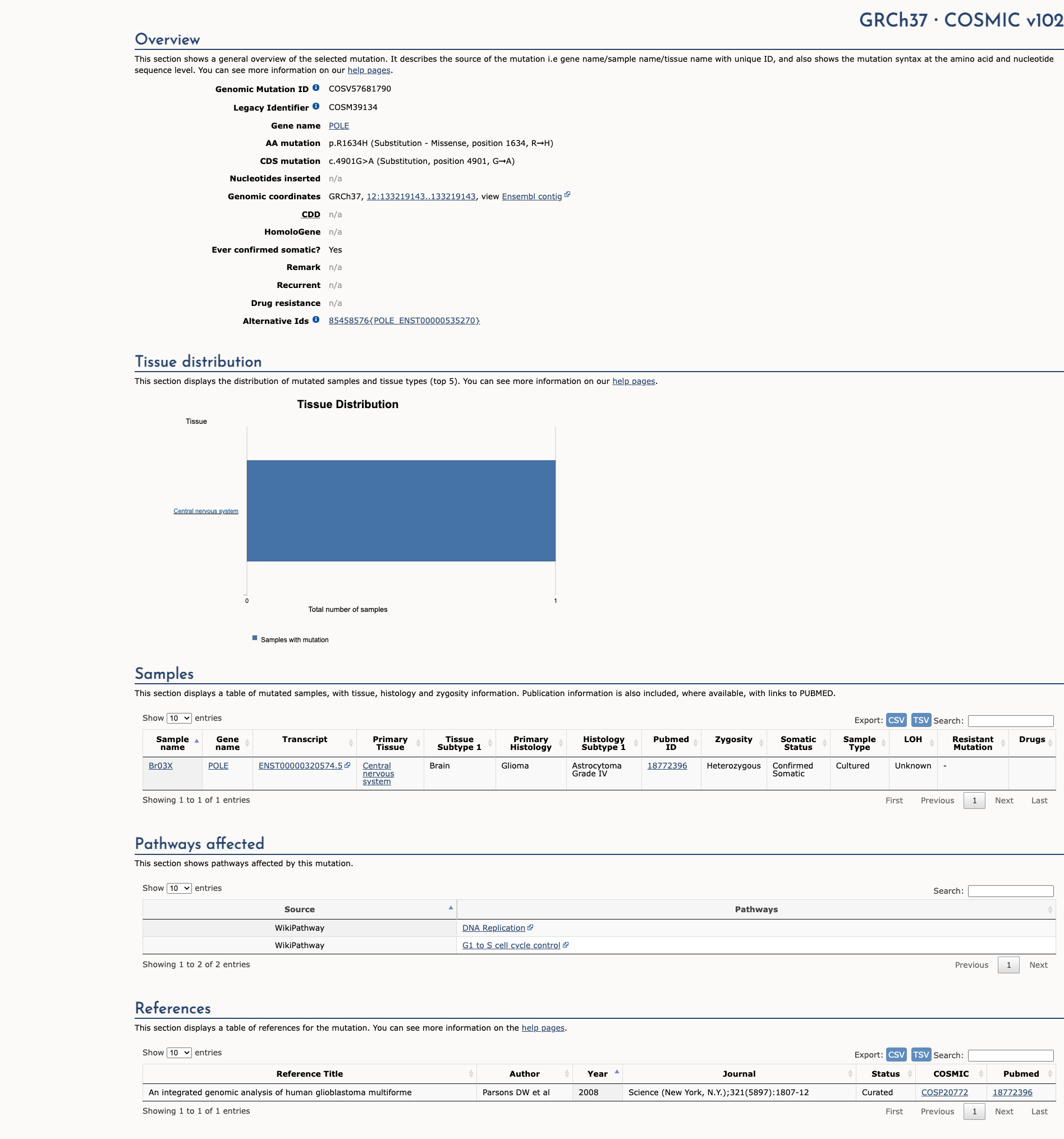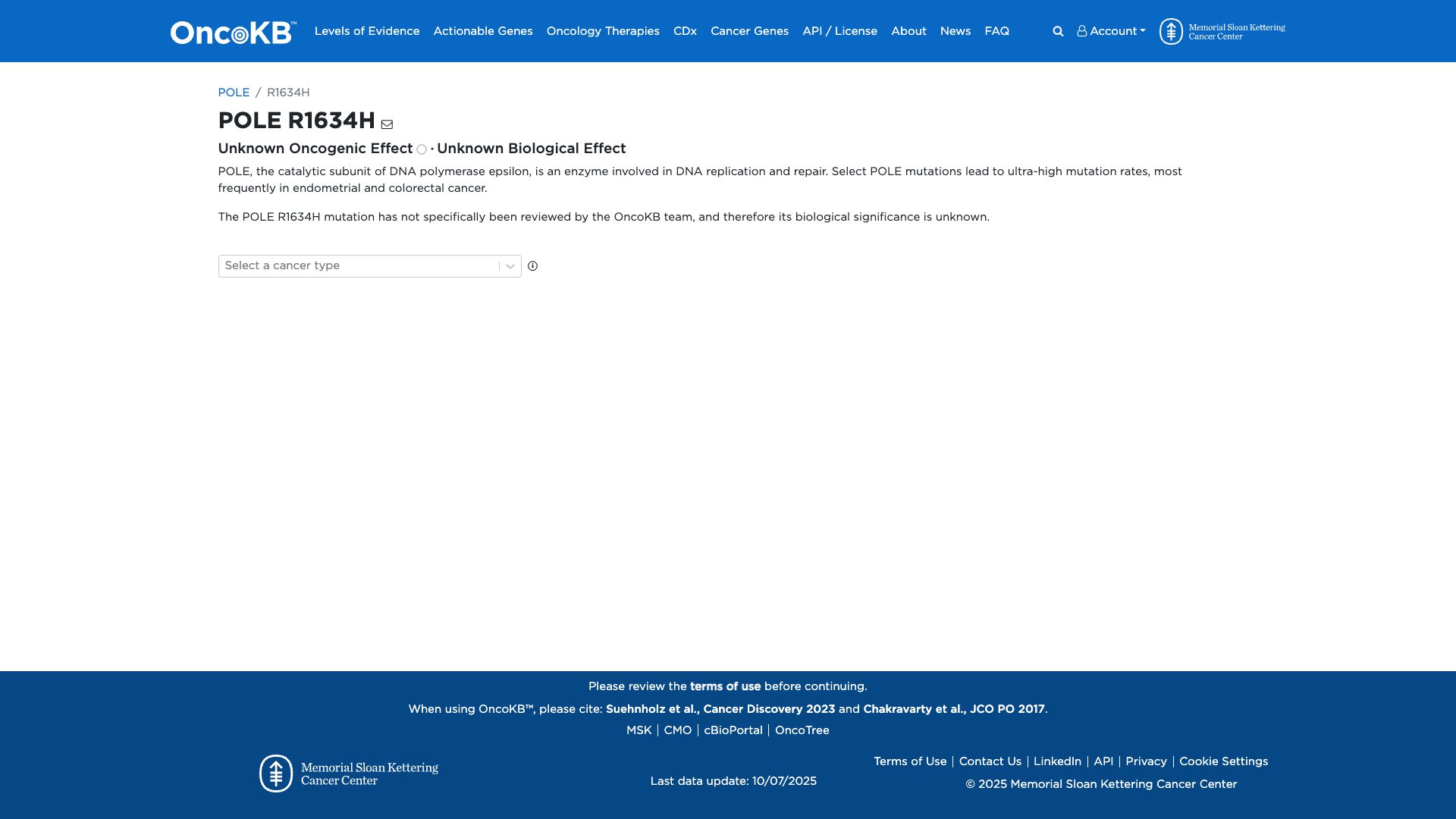POLE c.4901G>A, p.Arg1634His
NM_006231.4:c.4901G>A
COSMIC ID: COSM39134
Variant of Uncertain Significance (VUS)
The POLE c.4901G>A (p.R1634H) missense variant is extremely rare in population databases (PM2) and computational evidence supports a benign effect (BP4). No other supporting pathogenic or benign criteria are met. The variant remains classified as a Variant of Uncertain Significance.
ACMG/AMP Criteria Applied
PM2
BP4
Genetic Information
Gene & Transcript Details
Gene
POLE
Transcript
NM_006231.4
MANE Select
Total Exons
49
Strand
Reverse (−)
Reference Sequence
NC_000012.11
Alternative Transcripts
| ID | Status | Details |
|---|---|---|
| NM_006231.2 | Alternative | 49 exons | Reverse |
| NM_006231.3 | RefSeq Select | 49 exons | Reverse |
Variant Details
HGVS Notation
NM_006231.4:c.4901G>A
Protein Change
R1634H
Location
Exon 37
(Exon 37 of 49)
5'Exon Structure (49 total)3'
Functional Consequence
Loss of Function
Related Variants
No evidence of other pathogenic variants at position 1634 in gene POLE
Alternate Identifiers
COSM39134
Variant interpretation based on transcript NM_006231.4
Genome Browser
Loading genome browser...
HGVS InputNM_006231:c.4901G>A
Active Tracks
ConservationRefSeqClinVargnomAD
Navigation tips: Use mouse to drag and zoom. Click on features for details.
Clinical Data
Global Frequency
0.00438%
Rare
Highest in Population
African/African American
0.0308%
Low Frequency
Global: 0.00438%
African/African American: 0.0308%
0%
0.05%
0.1%
1%
5%
10%+
Allele Information
Total: 251048Alt: 11Homozygotes: 0
ACMG Criteria Applied
PM2
This variant is present in gnomAD (MAF= 0.00438%, 11/251048 alleles, homozygotes = 0) and at a higher frequency in the African/African American population (MAF= 0.0308%, 5/16228 alleles, homozygotes = 0). The variant is rare (MAF < 0.1%), supporting PM2 criterion application.
Classification
1 publications
Uncertain Significance (VUS)
Based on 6 submitter reviews in ClinVar
Submitter Breakdown
6 VUS
Pathogenic
Likely Path.
VUS
Likely Benign
Benign
Publications (1)
This sequence change replaces arginine, which is basic and polar, with histidine, which is basic and polar, at codon 1634 of the POLE protein (p.Arg1634His). This variant is present in population databases (rs760149463, gnomAD 0.03%). This missense change has been observed in individual(s) with colorectal cancer (PMID: 35534704). ClinVar contains an entry for this variant (Variation ID: 240545). Invitae Evidence Modeling of protein sequence and biophysical properties (such as structural, functional, and spatial information, amino acid conservation, physicochemical variation, residue mobility, and thermodynamic stability) indicates that this missense variant is not expected to disrupt POLE protein function with a negative predictive value of 80%. In summary, the available evidence is currently insufficient to determine the role of this variant in disease. Therefore, it has been classified as a Variant of Uncertain Significance.
Clinical Statement
This variant has been reported in ClinVar as Uncertain significance (6 clinical laboratories).
Functional Impact
Functional Domain
Hotspot Status
Not a hotspot
Domain Summary
This variant is not located in a mutational hotspot or critical domain (0 mutations).
Related Variants in This Domain
No evidence of other pathogenic variants at position 1634 in gene POLE
Computational Analysis
Pathogenicity Predictions
REVEL Score
0.168
0.168
Likely Benign0.0
Uncertain (Low)0.2
Uncertain (Med)0.5
Likely Pathogenic0.75
REVEL scores ≥ 0.75 are strong evidence (PP3)
Predictor Consensus
Mixed/VUS
PP3 Applied
No
Additional Predictors
Benign:
CADD: 3.12polyphen_prediction: benignmetasvm: Tmetalr: Tprimateai: T
Neutral: Show all
VCEP Guidelines
Applied ACMG/AMP Criteria (VCEP Specific)
PVS1
PVS1 (Not Applied) Strength Modified
According to standard ACMG guidelines, the rule for PVS1 is: "Null variant (nonsense, frameshift, canonical ±1 or ±2 splice sites, initiation codon, single or multi-exon deletion) in a gene where loss of function is a known mechanism of disease". The evidence for this variant shows: this is a missense change (c.4901G>A, p.R1634H), not a null variant. Therefore, this criterion is not applied.
PS1
PS1 (Not Applied) Strength Modified
According to standard ACMG guidelines, the rule for PS1 is: "Same amino acid change as a previously established pathogenic variant irrespective of nucleotide change". The evidence for this variant shows: no other pathogenic variant at codon 1634 has been reported. Therefore, this criterion is not applied.
PS2
PS2 (Not Applied) Strength Modified
According to standard ACMG guidelines, the rule for PS2 is: "De novo (both maternity and paternity confirmed) in a patient with the disease and no family history". The evidence for this variant shows: no de novo data available. Therefore, this criterion is not applied.
PS3
PS3 (Not Applied) Strength Modified
According to standard ACMG guidelines, the rule for PS3 is: "Well-established functional studies supportive of a damaging effect on the gene or gene product". The evidence for this variant shows: no functional studies have been performed. Therefore, this criterion is not applied.
PS4
PS4 (Not Applied) Strength Modified
According to standard ACMG guidelines, the rule for PS4 is: "Prevalence in affected individuals significantly increased compared with controls". The evidence for this variant shows: no case-control or prevalence data in affected individuals. Therefore, this criterion is not applied.
PM1
PM1 (Not Applied) Strength Modified
According to standard ACMG guidelines, the rule for PM1 is: "Located in a mutational hot spot and/or critical and well-established functional domain without benign variation". The evidence for this variant shows: R1634 is not known to reside in a documented hotspot or critical domain without benign variation. Therefore, this criterion is not applied.
PM2
PM2 (Moderate)
According to standard ACMG guidelines, the rule for PM2 is: "Absent from controls (or at extremely low frequency if recessive)". The evidence for this variant shows: MAF=0.00438% in gnomAD, extremely rare (below 0.1%). Therefore, this criterion is applied at Moderate strength because the variant is absent or at extremely low frequency in population databases.
PM3
PM3 (Not Applied) Strength Modified
According to standard ACMG guidelines, the rule for PM3 is: "Detected in trans with a pathogenic variant for recessive disorders". The evidence for this variant shows: no data on trans configuration with a pathogenic variant. Therefore, this criterion is not applied.
PM4
PM4 (Not Applied) Strength Modified
According to standard ACMG guidelines, the rule for PM4 is: "Protein length changes due to in-frame deletions/insertions or stop-loss variants". The evidence for this variant shows: this is a missense substitution without protein length change. Therefore, this criterion is not applied.
PM5
PM5 (Not Applied) Strength Modified
According to standard ACMG guidelines, the rule for PM5 is: "Novel missense change at an amino acid residue where a different pathogenic missense change has been seen before". The evidence for this variant shows: no other pathogenic missense reported at residue R1634. Therefore, this criterion is not applied.
PM6
PM6 (Not Applied) Strength Modified
According to standard ACMG guidelines, the rule for PM6 is: "Assumed de novo, without confirmation of paternity and maternity". The evidence for this variant shows: no de novo data. Therefore, this criterion is not applied.
PP1
PP1 (Not Applied) Strength Modified
According to standard ACMG guidelines, the rule for PP1 is: "Co-segregation with disease in multiple affected family members". The evidence for this variant shows: no family segregation data. Therefore, this criterion is not applied.
PP2
PP2 (Not Applied) Strength Modified
According to standard ACMG guidelines, the rule for PP2 is: "Missense variant in a gene with a low rate of benign missense variation and where missense variants are a common mechanism of disease". The evidence for this variant shows: POLE pathogenic variants are largely in the exonuclease domain, R1634 lies outside that domain and benign variation rate is not defined for this region. Therefore, this criterion is not applied.
PP3
PP3 (Not Applied) Strength Modified
According to standard ACMG guidelines, the rule for PP3 is: "Multiple lines of computational evidence support a deleterious effect on the gene or gene product". The evidence for this variant shows: in silico tools (CADD 3.12, REVEL 0.17, PolyPhen benign, SpliceAI no impact) predict benign. Therefore, this criterion is not applied.
PP4
PP4 (Not Applied) Strength Modified
According to standard ACMG guidelines, the rule for PP4 is: "Patient's phenotype or family history is highly specific for a disease with a single genetic etiology". The evidence for this variant shows: no patient phenotype or family history provided. Therefore, this criterion is not applied.
PP5
PP5 (Not Applied) Strength Modified
According to standard ACMG guidelines, the rule for PP5 is: "Reputable source reports variant as pathogenic, but without accessible evidence". The evidence for this variant shows: no reputable source reports this as pathogenic. Therefore, this criterion is not applied.
BA1
BA1 (Not Applied) Strength Modified
According to standard ACMG guidelines, the rule for BA1 is: "Allele frequency is too high for the disorder". The evidence for this variant shows: MAF=0.00438%, below threshold for BA1 (>5%). Therefore, this criterion is not applied.
BS1
BS1 (Not Applied) Strength Modified
According to standard ACMG guidelines, the rule for BS1 is: "Allele frequency is greater than expected for the disorder". The evidence for this variant shows: MAF well below expected maximum for POLE-related disease. Therefore, this criterion is not applied.
BS2
BS2 (Not Applied) Strength Modified
According to standard ACMG guidelines, the rule for BS2 is: "Observed in a healthy adult individual for a dominant disorder with full penetrance expected at an early age". The evidence for this variant shows: no direct evidence of observation in unaffected individuals with confirmed health status. Therefore, this criterion is not applied.
BS3
BS3 (Not Applied) Strength Modified
According to standard ACMG guidelines, the rule for BS3 is: "Well-established functional studies show no damaging effect on protein function or splicing". The evidence for this variant shows: no functional studies performed. Therefore, this criterion is not applied.
BS4
BS4 (Not Applied) Strength Modified
According to standard ACMG guidelines, the rule for BS4 is: "Lack of segregation in affected family members". The evidence for this variant shows: no segregation data available. Therefore, this criterion is not applied.
BP1
BP1 (Not Applied) Strength Modified
According to standard ACMG guidelines, the rule for BP1 is: "Missense variant in a gene where only loss-of-function causes disease". The evidence for this variant shows: POLE disease mechanism is missense in exonuclease domain rather than LOF. Therefore, this criterion is not applied.
BP2
BP2 (Not Applied) Strength Modified
According to standard ACMG guidelines, the rule for BP2 is: "Observed in trans with a pathogenic variant for a dominant disorder or in cis for a recessive disorder". The evidence for this variant shows: no phase or cis/trans data available. Therefore, this criterion is not applied.
BP3
BP3 (Not Applied) Strength Modified
According to standard ACMG guidelines, the rule for BP3 is: "In-frame deletions/insertions in a repetitive region without known function". The evidence for this variant shows: this is a missense change, not an in-frame indel. Therefore, this criterion is not applied.
BP4
BP4 (Supporting)
According to standard ACMG guidelines, the rule for BP4 is: "Multiple lines of computational evidence suggest no impact on gene or gene product". The evidence for this variant shows: CADD 3.12, REVEL 0.17, PolyPhen benign, SpliceAI no splicing impact. Therefore, this criterion is applied at Supporting strength because computational data consistently predict a benign effect.
BP5
BP5 (Not Applied) Strength Modified
According to standard ACMG guidelines, the rule for BP5 is: "Variant found in a case with an alternate molecular basis for disease". The evidence for this variant shows: no alternate molecular basis reported. Therefore, this criterion is not applied.
BP6
BP6 (Not Applied) Strength Modified
According to standard ACMG guidelines, the rule for BP6 is: "Reputable source reports variant as benign, but without accessible evidence". The evidence for this variant shows: no reputable source reports benign. Therefore, this criterion is not applied.
BP7
BP7 (Not Applied) Strength Modified
According to standard ACMG guidelines, the rule for BP7 is: "Synonymous variant with no predicted impact on splicing". The evidence for this variant shows: this is a missense change, not synonymous. Therefore, this criterion is not applied.



